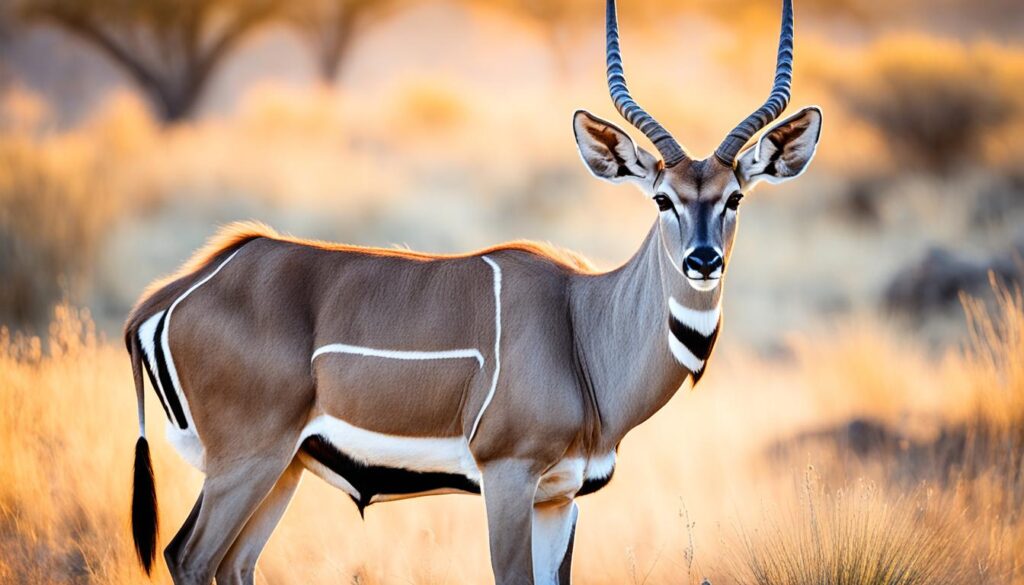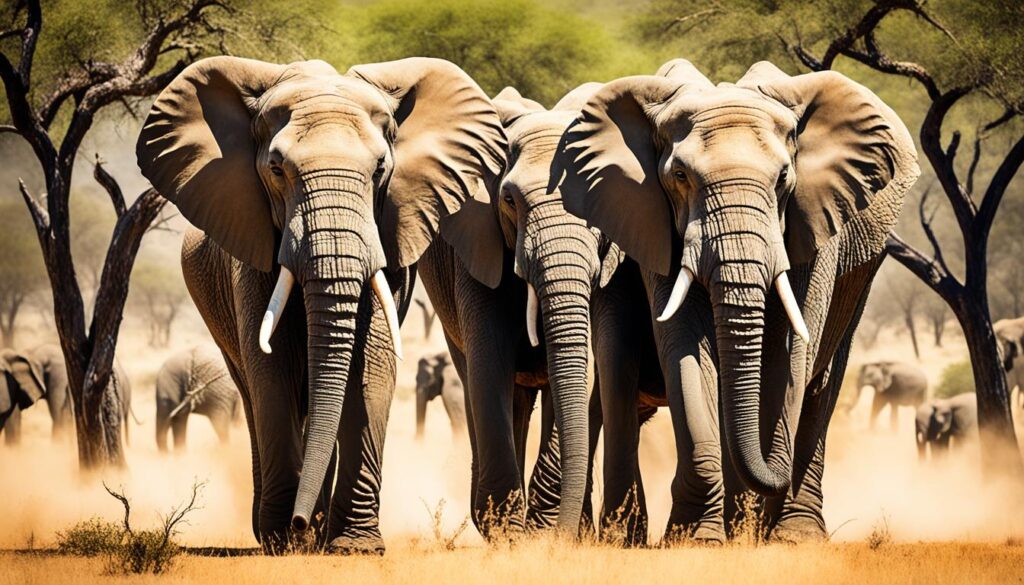Did you know that Namibia is home to a staggering array of diverse and unique wildlife? With its expansive landscapes and remarkable desert conditions, Namibia offers an unparalleled safari experience that will leave you in awe. From rare desert-adapted elephants to graceful springboks, the animal sightings in Namibia are simply extraordinary.

Key Takeaways:
- Namibia is a haven for wildlife enthusiasts, offering a wide variety of animals to see and photograph.
- The best time to visit for optimal game viewing is during the dry winter months from May to October.
- Some of the iconic animals you can encounter in Namibia include the majestic oryx, the impressive kudu, and the graceful zebras.
- Conservation efforts are crucial in maintaining the delicate balance of Namibia’s fragile ecosystems and protecting its unique wildlife.
- Exploring the national parks and driving through the countryside are excellent ways to immerse yourself in the beauty of Namibia’s wildlife.
Oryx
The oryx, also known as the gemsbok, is an iconic antelope species that holds the distinction of being the national animal of Namibia. These magnificent creatures can be found throughout the country, including in the Southern African towns and villages. However, if you want to witness the splendor of the oryx in its natural habitat, there is no better place than the dunes of Sossusvlei at sunrise.
Oryxes are renowned for their striking striped and tan appearance, which allows them to blend seamlessly with the sandy landscape of Namibia. Their long, sharp horns proudly adorn their heads, serving both as a means of defense and a symbol of their extraordinary adaptability to the harsh desert conditions.
As graceful and agile desert dwellers, oryxes have evolved to survive in extreme temperatures and arid environments. They are capable of withstanding long periods without drinking water by efficiently extracting moisture from the plants they consume. Observing these majestic animals as they navigate the challenging terrain is a truly remarkable experience for any wildlife enthusiast or nature lover.
Witnessing the oryx in the wild is a testament to the resilience and beauty of Namibia’s wildlife. Whether you’re capturing their elegance through the lens of a camera or simply taking in their magnificent presence, encountering these iconic antelopes is an unforgettable experience.
Kudu
Kudus are large antelopes known for their spiral horns and mane of long hair. They can be found throughout central and northern Namibia, particularly in Windhoek and Etosha National Park. Kudus are light in build and are known for their leaping ability, which allows them to jump over fences and other obstacles with ease.
Namibia offers a unique opportunity to observe the majestic kudu in its natural habitat. With its iconic spiral horns and striking appearance, the kudu is a prized sighting for wildlife enthusiasts and photographers alike. Whether you’re exploring the grasslands of Windhoek or embarking on a safari in Etosha National Park, you’re likely to encounter these graceful creatures.

The kudu’s long, twisted horns are an impressive sight to behold. They can grow up to 1.8 meters in length and are adorned with graceful curves. These horns are not only a display of the male kudu’s dominance and strength but also serve a practical purpose in defending against predators.
In addition to their impressive horns, kudus are known for their distinct coloration and markings. They have a reddish-brown coat with vertical white stripes along their sides, providing effective camouflage in their natural habitat. The male kudus also possess a beautiful mane of long hair, which adds to their regal appearance.
Adaptations for Survival
The kudu’s physical characteristics and behavior have evolved to help them thrive in the harsh environments of Namibia. Their light build and slender legs allow them to navigate through dense vegetation and leap effortlessly over obstacles. This agility is especially beneficial when it comes to escaping predators or reaching high branches to feed.
Kudus are primarily browsers, meaning they feed on leaves, shoots, and fruits from a variety of plant species. This flexible diet enables them to adapt to different habitats and ensures their survival even in times of scarcity. They are also able to extract moisture from their food, reducing their dependence on water sources.
Another fascinating adaptation of the kudu is their keen sense of hearing and sharp eyesight. They have large, rounded ears that can rotate independently, allowing them to detect even the slightest sounds. Their well-developed eyes provide excellent peripheral vision, enabling them to spot potential threats or opportunities from a distance.
Conservation Status and Threats
The kudu population in Namibia is currently stable, thanks to successful conservation efforts and the country’s commitment to protecting its wildlife. However, like many other species, kudus face various threats to their survival.
Habitat loss, caused by human activities such as agriculture and urbanization, poses a significant threat to kudus. As their natural habitats shrink, kudus are forced to adapt to new environments or compete with other species for limited resources.
Illegal hunting and poaching also pose a threat to the kudu population. The demand for kudu horns, which are considered a valuable commodity in some cultures, has led to illegal hunting and trade. This unsustainable practice puts the kudu population at risk and disrupts the delicate balance of Namibia’s ecosystems.
Efforts to protect kudus and their habitats include the establishment of protected areas and national parks, as well as initiatives to raise awareness about the importance of conservation. By promoting responsible tourism and sustainable practices, Namibia aims to ensure the long-term survival of this majestic antelope species.
Springbok
Springboks are one of the most abundant antelope species in Namibia. They are known for their graceful jumps and can leap up to 2 meters off the ground. Large herds of springboks can be found in the Namib Desert, central Namibia, and in Etosha National Park. The springbok is also the national animal of South Africa.
Springbok Fact Sheet
| Common Name | Springbok |
|---|---|
| Scientific Name | Antidorcas marsupialis |
| Family | Bovidae |
| Habitat | Namib Desert, central Namibia, Etosha National Park |
| Size | Length: 1.2m-1.4m; Height: 75cm-85cm |
| Diet | Herbivorous, primarily grass |
| Conservation Status | Least Concern |
Elephant
Namibia is home to both bush-dwelling and desert-adapted elephants. The desert-adapted elephants can be found in the northern regions of Namibia, particularly in Damaraland and the Skeleton Coast National Park. These elephants have unique adaptations, such as smaller bodies, longer legs, and larger feet to navigate the sandy terrain. They can also survive for long periods without water, unlike savanna elephants.

If you’re lucky enough to encounter these majestic creatures during your visit to Namibia, you’ll witness their incredible strength and intelligence. Observing elephants in their natural habitat is a truly awe-inspiring experience. Whether you spot them in the lush bushland or the arid desert, the presence of these magnificent animals will leave a lasting impression.
Zebras
Namibia is home to two species of zebras, including the Burchell’s zebra and Hartmann’s zebra. Burchell’s zebras are widespread throughout the country and can be found in large herds. Hartmann’s zebras, on the other hand, prefer the rocky terrain of western Etosha National Park. Zebras are known for their distinctive black and white striped coat.
Zebras are one of the most iconic and recognizable animals in the world. They have fascinated both scientists and wildlife enthusiasts with their unique behavior and striking appearance. The black and white stripes of zebras serve as a form of camouflage and help to confuse predators, making it difficult for them to single out an individual zebra in a herd.
In Namibia, zebras can be found in various habitats, including grasslands, savannas, and even deserts. They are herbivores and primarily feed on grass and leaves. Zebras are highly social animals and live in family groups known as harems. These harems consist of a dominant male called a stallion, several females, and their offspring.
One interesting fact about zebras is that no two individuals have the same stripe pattern. This unique pattern acts as a natural identification system, allowing zebras to recognize each other and form strong social bonds within their groups. It also helps to confuse predators, making it difficult for them to target a specific zebra.
Zebras in Namibia play an essential role in the ecosystem as grazers. By feeding on grass, they help to trim and control the vegetation, promoting healthy growth and preventing the overgrowth of certain plant species. Their presence also attracts other herbivores and provides a vital food source for predators such as lions and hyenas.
When visiting Namibia, encountering zebras in their natural habitat is a memorable experience. Whether observing them in a national park or on a safari, witnessing these majestic animals in person is a highlight of any wildlife adventure in Namibia.
Conclusion
Namibia is a wildlife enthusiast’s dream destination. With its diverse range of animals, stunning landscapes, and unique safari experiences, it offers an unforgettable adventure for nature lovers. From the iconic oryx to the graceful kudu, the country is teeming with fascinating creatures waiting to be discovered.
Whether you choose to explore the vast national parks or embark on a scenic drive through the countryside, you are sure to encounter the incredible wildlife that calls Namibia home. Don’t forget to bring your camera to capture the awe-inspiring beauty of these animals in their natural habitats.
Namibia’s commitment to wildlife conservation is evident, as it provides a safe haven for numerous species. The country’s dedication to preserving its natural heritage ensures that future generations can continue to marvel at the wonders of Namibia’s wildlife.
In conclusion, Namibia is the perfect destination for an unforgettable wildlife adventure. Immerse yourself in the splendor of nature and create memories that will last a lifetime.
